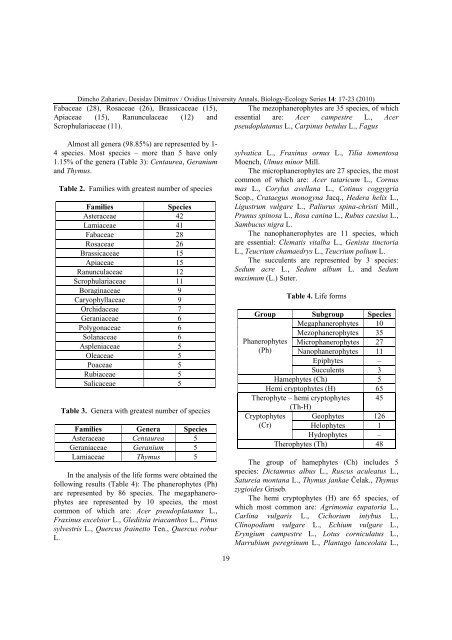VOLUM OMAGIAL - Facultatea de Ştiinţe ale Naturii şi Ştiinţe Agricole
VOLUM OMAGIAL - Facultatea de Ştiinţe ale Naturii şi Ştiinţe Agricole
VOLUM OMAGIAL - Facultatea de Ştiinţe ale Naturii şi Ştiinţe Agricole
Create successful ePaper yourself
Turn your PDF publications into a flip-book with our unique Google optimized e-Paper software.
Dimcho Zahariev, Desislav Dimitrov / Ovidius University Annals, Biology-Ecology Series 14: 17-23 (2010)<br />
Fabaceae (28), Rosaceae (26), Brassicaceae (15),<br />
Apiaceae (15), Ranunculaceae (12) and<br />
Scrophulariaceae (11).<br />
Almost all genera (98.85%) are represented by 1-<br />
4 species. Most species – more than 5 have only<br />
1.15% of the genera (Table 3): Centaurea, Geranium<br />
and Thymus.<br />
Table 2. Families with greatest number of species<br />
Families Species<br />
Asteraceae 42<br />
Lamiaceae 41<br />
Fabaceae 28<br />
Rosaceae 26<br />
Brassicaceae 15<br />
Apiaceae 15<br />
Ranunculaceae 12<br />
Scrophulariaceae 11<br />
Boraginaceae 9<br />
Caryophyllaceae 9<br />
Orchidaceae 7<br />
Geraniaceae 6<br />
Polygonaceae 6<br />
Solanaceae 6<br />
Aspleniaceae 5<br />
Oleaceae 5<br />
Poaceae 5<br />
Rubiaceae 5<br />
Salicaceae 5<br />
Table 3. Genera with greatest number of species<br />
Families Genera Species<br />
Asteraceae Centaurea 5<br />
Geraniaceae Geranium 5<br />
Lamiaceae Thymus 5<br />
In the analysis of the life forms were obtained the<br />
following results (Table 4): The phanerophytes (Ph)<br />
are represented by 86 species. The megaphanerophytes<br />
are represented by 10 species, the most<br />
common of which are: Acer pseudoplatanus L.,<br />
Fraxinus excelsior L., Gleditsia triacanthos L., Pinus<br />
sylvestris L., Quercus frainetto Ten., Quercus robur<br />
L.<br />
19<br />
The mezophanerophytes are 35 species, of which<br />
essential are: Acer campestre L., Acer<br />
pseudoplatanus L., Carpinus betulus L., Fagus<br />
sylvatica L., Fraxinus ornus L., Tilia tomentosa<br />
Moench, Ulmus minor Mill.<br />
The microphanerophytes are 27 species, the most<br />
common of which are: Acer tataricum L., Cornus<br />
mas L., Corylus avellana L., Cotinus coggygria<br />
Scop., Crataegus monogyna Jacq., He<strong>de</strong>ra helix L.,<br />
Ligustrum vulgare L., Paliurus spina-christi Mill.,<br />
Prunus spinosa L., Rosa canina L., Rubus caesius L.,<br />
Sambucus nigra L.<br />
The nanophanerophytes are 11 species, which<br />
are essential: Clematis vitalba L., Genista tinctoria<br />
L., Teucrium chamaedrys L., Teucrium polium L.<br />
The succulents are represented by 3 species:<br />
Sedum acre L., Sedum album L. and Sedum<br />
maximum (L.) Suter.<br />
Table 4. Life forms<br />
Group Subgroup Species<br />
Megaphanerophytes 10<br />
Mezophanerophytes 35<br />
Phanerophytes Microphanerophytes 27<br />
(Ph) Nanophanerophytes 11<br />
Epiphytes –<br />
Succulents 3<br />
Hamephytes (Ch) 5<br />
Hemi cryptophytes (H) 65<br />
Therophyte – hemi cryptophytes 45<br />
(Th-H)<br />
Cryptophytes Geophytes 126<br />
(Cr)<br />
Helophytes 1<br />
Hydrophytes –<br />
Therophytes (Th) 48<br />
The group of hamephytes (Ch) inclu<strong>de</strong>s 5<br />
species: Dictamnus albus L., Ruscus aculeatus L.,<br />
Satureia montana L., Thymus jankae Čelak., Thymus<br />
zygioi<strong>de</strong>s Griseb.<br />
The hemi cryptophytes (H) are 65 species, of<br />
which most common are: Agrimonia eupatoria L.,<br />
Carlina vulgaris L., Cichorium intybus L.,<br />
Clinopodium vulgare L., Echium vulgare L.,<br />
Eryngium campestre L., Lotus corniculatus L.,<br />
Marrubium peregrinum L., Plantago lanceolata L.,





